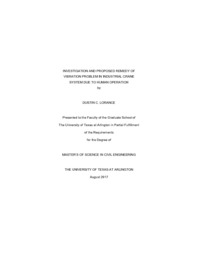
ATTENTION: The works hosted here are being migrated to a new repository that will consolidate resources, improve discoverability, and better show UTA's research impact on the global community. We will update authors as the migration progresses. Please see MavMatrix for more information.
Show simple item record
| dc.contributor.advisor | Chao, Shih-Ho | |
| dc.creator | Lorance, Dustin C | |
| dc.date.accessioned | 2023-09-11T15:00:54Z | |
| dc.date.available | 2023-09-11T15:00:54Z | |
| dc.date.created | 2017-08 | |
| dc.date.submitted | August 2017 | |
| dc.identifier.uri | http://hdl.handle.net/10106/31674 | |
| dc.description.abstract | A recent investigation of a crane system began when a facilities manager reported a runway beam under-going torsional vibration during operations. The investigation revealed the runway beam’s twisting was caused by resonance vibration due to “inching” of the crane hoist. A Fourier spectrum analysis revealed that one of the harmonic frequencies of this rhythmical motion coincided very close to the natural frequency of the crane system. The runway beam, although met strength requirements, failed to meet serviceability criteria due to the resonance vibration. Resonance vibration issues due to human activity in crane operation (inching, sway, etc.) is often encountered by engineers when designing crane runways. These issues are even more familiar in long-span crane runways where limited bracing opportunities exist. While vibration resonance issues, of all modes, may be known to many designers of crane structures, the time required to run an in-depth dynamic analysis is usually not economical for such a simple structure. Possible critical vibration issues coupled with the inability to perform an in-depth analysis requires design engineers to use very conservative design recommendations regarding vibration. The few design recommendations found in current standards are very broad and offer little-to-no commentary, and the application of such design recommendations may or may not support a critical vibration mode. The resulting overdesign may reinforce a vibrational mode which is not necessarily an object of concern. The cost associated with the overdesign could have possibly been directed towards a more vibrational sensitive mode. This study first investigated the cause of the resonance vibration. Secondly, through extensive finite element analyses (FEA), a practical solution is recommended. Lastly, using the FEA results, alongside current standards, a set of design equations are formulated to aid in future crane runway vibration design in addition to the limited vibration research. | |
| dc.format.mimetype | application/pdf | |
| dc.language.iso | en_US | |
| dc.subject | Crane | |
| dc.subject | Runway | |
| dc.subject | Torsion | |
| dc.subject | Vibration | |
| dc.title | INVESTIGATION AND PROPOSED REMEDY OF VIBRATION PROBLEM IN INDUSTRIAL CRANE SYSTEM DUE TO HUMAN OPERATION | |
| dc.type | Thesis | |
| dc.date.updated | 2023-09-11T15:00:54Z | |
| thesis.degree.department | Civil Engineering | |
| thesis.degree.grantor | The University of Texas at Arlington | |
| thesis.degree.level | Masters | |
| thesis.degree.name | Master of Engineering in Civil Engineering | |
| dc.type.material | text | |
| dc.creator.orcid | 0000-0003-3982-2485 | |
Files in this item
- Name:
- LORANCE-THESIS-2017.pdf
- Size:
- 10.15Mb
- Format:
- PDF
This item appears in the following Collection(s)
Show simple item record


